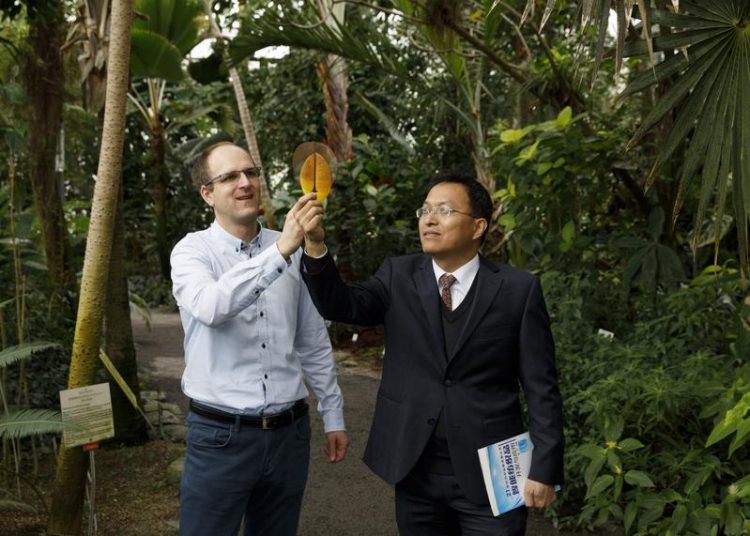Efficient, Economical and Aesthetic: Researchers Build Electrodes from Leaves

Before, after: left the magnolia leaf, right the electrode. Jonathan Plentz (left) and Guobin Jia from Leibniz IPHT built electrodes from leaves of the purple magnolia. Sven Döring/ Leibniz-IPHT
“We took our inspiration from nature's perfectly ingenious system and used the leaf veins of deciduous leaves to construct electrodes with a high power density and low material consumption,” reports Dr. Guobin Jia from Leibniz IPHT. He is first author of the study, which was published in the renowned journal Nano-Micro Letters.
Electrodes from the magnolia tree
Plant leaves behave like photochemical factories that convert water and CO2 into carbohydrates and oxygen through photosynthesis. Solar cells imitate this principle by converting sunlight directly into electricity. The fine, net-like branched leaf veins supply the leaf cells with water and nutrients and transport the carbohydrates produced by photosynthesis to other parts of the plant.
“Thus, they have much in common with the electrodes in solar cells, batteries or LEDs that collect or distribute electrical current or signals,” explains Dr. Jonathan Plentz, who heads the “Photonic Thin Film Systems” working group at Leibniz IPHT. However, while the leaf veins remain functional even if parts of them are damaged, fractures in solar cells lead to a severe deterioration in performance.
The researchers have now taken advantage of the efficient transport network of the leaf veins to transmit electrical current. They detached the leaf green from leaves of the purple magnolia (Magnolia liliiflora), metallized the veins with copper and allowed electric current to flow through them. The leaf skeletons became transparent, conductive electrodes.
The sheet resistance is two orders of magnitude lower — and thus the electrical performance is correspondingly better — than with conventional ITO (indium tin oxide) thin films, which are used for transparent electrodes in touch screens or thin-film solar cells, for example. The sheet electrodes also proved superior to conventional ones in terms of optical transmission in the UV and infrared range.
Using leaves as an example to design the mobility of the future
Using structures from nature could prove to be not only more efficient but also cheaper. “We need much less material for electrodes made from leaves,” explains Jonathan Plentz. In addition, the copper consumption for metallization is very low. The researcher therefore sees the metallized leaves as an alternative to conventional electrodes for solar cells. “The branched structure of the leaf veins is optimally designed for transport.”
In contrast, the comb-like geometry of the electrodes on conventional solar cells requires an even silver layer that is unnecessarily thick in the peripheral areas. If the superior, vein-like structures of broadleafs were used for high-performance electrodes, Guobin Jia estimates that the consumption of silver for the mass production of solar cells could be reduced to less than a tenth of the current level.
In addition, the research team believes that the electrically conductive and optically transparent electrodes made of natural materials could open up new possibilities for the construction of batteries and supercondesators as well as for the design of novel LEDs or displays. “In general, we can learn from the efficiency of nature's solutions,” says Guobin Jia.
According to the principle of biomimicry, these solutions could also be applied to our reality, for example to rethink the organization of modern transportation systems. “If we were able to better understand the excellent distribution and transport function of leaf veins with the help of a mathematical model, this could help to improve completely different transport processes that run in two directions,” says the researcher. This applies, for example, to road systems in large cities, data transmission in fiber optic networks or power grids.
Dr. Jonathan Plentz
Leibniz-Institut für Photonische Technologien
Forschungsabteilung Funktionale Grenzflächen
Arbeitsgruppe Photonische Dünnschichtsysteme
+49 (0) 3641 · 206-421
jonathan.plentz(a)leibniz-ipht.de
Guobin Jia, Jonathan Plentz et al., Biomimic Vein-Like Transparent Conducting Electrodes with Low Sheet Resistance and Metal Consumption, Nano-Micro Letters volume 12, Article number: 19 (2020). https://doi.org/10.1007/s40820-019-0359-9
https://www.leibniz-ipht.de/en/news/latest-news/detail/effizient-guenstig-und-ae…
Media Contact
All latest news from the category: Power and Electrical Engineering
This topic covers issues related to energy generation, conversion, transportation and consumption and how the industry is addressing the challenge of energy efficiency in general.
innovations-report provides in-depth and informative reports and articles on subjects ranging from wind energy, fuel cell technology, solar energy, geothermal energy, petroleum, gas, nuclear engineering, alternative energy and energy efficiency to fusion, hydrogen and superconductor technologies.
Newest articles

Pinpointing hydrogen isotopes in titanium hydride nanofilms
Although it is the smallest and lightest atom, hydrogen can have a big impact by infiltrating other materials and affecting their properties, such as superconductivity and metal-insulator-transitions. Now, researchers from…

A new way of entangling light and sound
For a wide variety of emerging quantum technologies, such as secure quantum communications and quantum computing, quantum entanglement is a prerequisite. Scientists at the Max-Planck-Institute for the Science of Light…

Telescope for NASA’s Roman Mission complete, delivered to Goddard
NASA’s Nancy Grace Roman Space Telescope is one giant step closer to unlocking the mysteries of the universe. The mission has now received its final major delivery: the Optical Telescope…



